|
|
When I was young I used to tinker a lot with electronics. It started with building simple crystal radios that I would listen to at night, using a long antenna through the bedroom, with my head below the blankets otherwise you would not hear a thing. It ended with building a SSB short-wave receiver and again I spent endless nights listening to radio amateurs from around the world … CQ DX? … CQ DX? ….
In those years, young Jobs and Gates made enter computers into people's homes and once Torvalds made his mark, my interest in electronics yielded to endless hours spent on developing Algol 68 Genie. So little time, so many interesting things to do …
Another passion of mine is music, mainly classical. Bach, Mozart, Beethoven, Wagner, Bruckner, Mahler, Rachmaninov, Pärt, I cannot hear enough. I have therefore also a keen interest in sound HiFi equipment.
Lately I needed to call on some of my now rusty electronics skills since I came into some older HiFi equipment in need of attention. I consulted the world wide web in search of service manuals and found many more people with an interest in keeping older HiFi in working condition. Now I had the opportunity to combine my passion for electronics, HiFi equipment and music … and do not forget durability, since we are actually extending the life of otherwise obsolete products.
The procedures described below involve opening and fixing electrical equipment, possibly exposing high-voltage parts that may give electrical shock, or exposing solid-state lasers, the beam of which (or its reflection) may irreversibly damage eyesight. What is described here is exactly what manufacturers warn you not to do, and with good reason. For your own safety, do not attempt opening or fixing HiFi equipment if you are not qualified to do so.
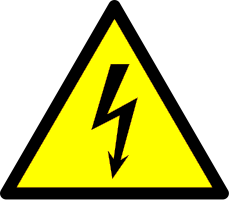
|
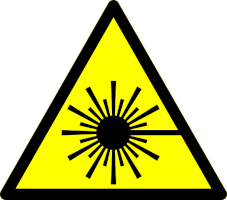
|
I am the proud owner of a recent DAB+ receiver. DAB+ should be the answer to hiss and static in FM reception. Indeed, tuner performance is nice, though I needed an antenna amplifier to get sufficient quality digital signal. Thirty years ago, engineers had to make the best of analogue FM radio. Brands like Luxman and Onkyo were really good at making high quality tuners. So I was pleasantly surprised to find at a thrift shop an Onkyo Integra T4057 that dates from the late 1980's.
I hooked it up to the DAB+ receiver but had to conclude that the DAB+ tuner sounded better than this once high-end tuner. Time to take the unit apart for inspection! The power supply had a large filter electrolytic capacitor that operated at an effective voltage only few Volts below the elco's maximum voltage so I supposed that after 30 years the elco would be quite dull.
I searched my soldering iron that I had not used for many years and replaced the elco's in the power supply but also the ones in the signal path - this time with maximum voltages well above actual load. The dead power indicator I replaced by a blue led to give it a contemporary touch. The unit was a bit scratched, so I subtly retouched the front with a little black paint.
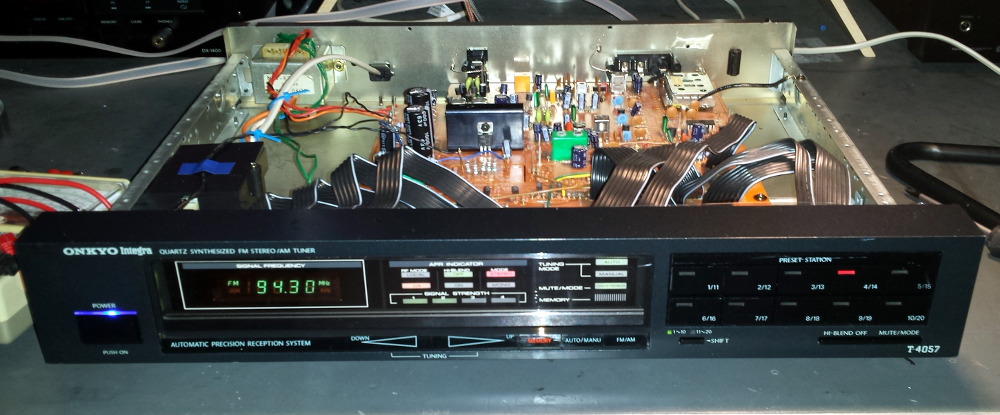
After this not too difficult operation, the unit sounds crystal clear and very musical, a nice open sound stage, really pleasant. Now it is the DAB+ tuner that sounds a bit dull in comparison … though the DAB+ tuner has no hiss. At normal listening levels, the hiss of the T4057 is hardly noticeable. Since I like to listen in the evening hours, after a while I found the blue led too bright in dim light, so I replaced it again by an orange one.
As said I like classical music and always have music playing while I am engaged in domestic activities. Even though vinyl makes a come-back, I will not part from my CD collection.
I do not want to start yet another discussion on whether vinyl is nicer than CD or vice versa. Arguments from physics, graphs and measurements are not the complete story - your personality and esthetic preferences make the way you experience your music unique. For me that is CDs in their cute jewel cases and discrete solid-state amps, for another person it will be vinyl with beautiful cover art and tube amps, and a next person may prefer flacc and not care for cover art at all.
I do have a modern CD player but I found, also in a thrift shop, a nice Onkyo CD player from the early 1990's. That was the time when I bought my first Onkyo HiFi set so this find brought back sweet memories. Also, shouldn't one play recordings on authentic instruments using a player from the recording's epoch … 🙂 ?
This one is equipped with 8 times oversampled 18-bit DACs, which at the time sounded really nice compared to the then common 4 times oversampled 16 bit DACs. The price was right, so I decided to take it home … if it would work it would be a bargain, if not I would have had hours of fun in trying to make it work.
The Onkyo needed thorough cleaning since it was dusty on the inside as well as on the outside. At first the unit seemed to play well. It would even play scratched CD's indicating that the laser still works well - this unit has a Sony mechanism that was known for its sturdy laser.
However, after some days its little problem showed up. It would load a disc only to throw it back at me. At first occasionally, later any disc was rejected. I had little to lose, and took the Sony mechanism apart. I quickly found the culprit - a rubber belt in the loading mechanism had stretched too much for the tray to close completely - the laser tried to find the initial track on the slightly misaligned disc, and after some seconds the unit gave up and ejected the disc.
I searched the web shops and to my surprise found replacement belts for this exact mechanism. However, since the rubber belt only needs to open and close the tray, a bit of wow or flutter would not matter. I simply replaced it with an equally sized O-seal from the plumbing department of the local DIY store. This is of course not recommended for cassette decks or turntables that need decent belts to avoid wow and flutter.
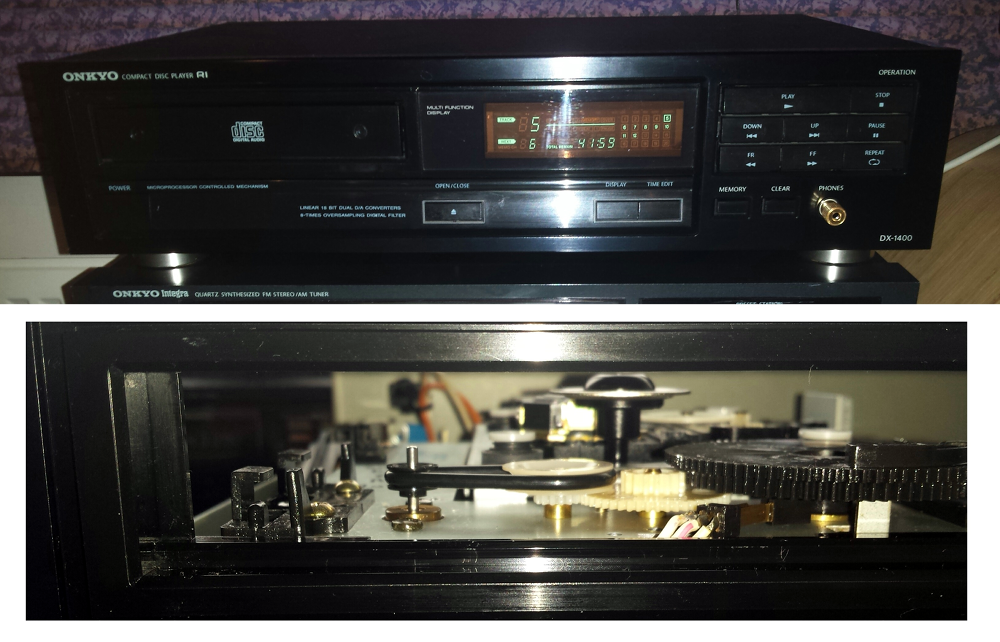
I also gave a minute dab of silicon-grease as lubricant here and there to make the tray and laser transport move easily again. After using the unit for a day or so I removed any excess lubricant. The unit works fine consistently since this 50 cents repair.
Compared to my recent player (optical interconnect to the DAC in the receiver), this 25-year-old player (analogue interconnect to the receiver) comes quite close - the new one having slightly clearer bass. The DX1400 must be delicately trimmed for optimal performance (there are several trimmers in the unit that you touch at your own peril) while the later single-bitters do not require such fine-tuning - after 25 years this might have influenced slightly the performance of the DX1400; however, I really enjoy the unit.
The equipment I described above is in my study which is a small room that does not allow for large speakers; bookshelf speakers are the only possibility in this room. The size of the room also rules out using a subwoofer: the wavelength of low bass tones is too large for the room which would result in an inconsistent bass reproduction. The bookshelf speakers themselves are almost vintage: a pair of Mission 731's that formerly formed the rear channel in a Dolby Surround system. I also happened to have the corresponding Mission 73C center speaker of that Dolby Surround system. The receiver I currently own is a two-channel device, so the 73C was sitting idly on top of a bookshelf.
In my small study the 731's perform quite well though the sound stage could be more firmly centered, by which I mean that when I move around the room, the sound stage moves with my position which is a bit weird. I wanted to test whether the 73C could help … but then I would need an extra amp to connect to the receiver's subwoofer pre-out, a mono channel without crossover. One good day I found a Denon POA F100, a three-channel power-amp for combination with a matching receiver that was not on offer; both units together would form a five-channel surround system. This cute little unit has comparable wattage as the receiver driving the 731's, so I decided to buy it to drive the 73C.
I could not find a service manual for the amp. Upon connecting the unit to the mains, the power indicator seemed dead though the speaker relays engaged, which was a good sign. Then I tested the unit with a test source in such way that if the amp was faulty, it would not cause serious damage. It appeared that the power indicator lights up once the unit is connected to peripheral equipment. In the end, all the unit needed was a good cleaning, and since the pre-amp (Onkyo) and power-amp (Denon) are not the same brand, an attenuator was needed to bring the 73C back at the volume of the 731's. I improvised the attenuator with a 20 kΩ trimmer soldered onto a twin RCA plug - I spliced an interconnect into two mono cables to connect pre-amp to attenuator and attenuator to the power-amp. The trimmer was set to a level at which the 73C just matches the 731's.
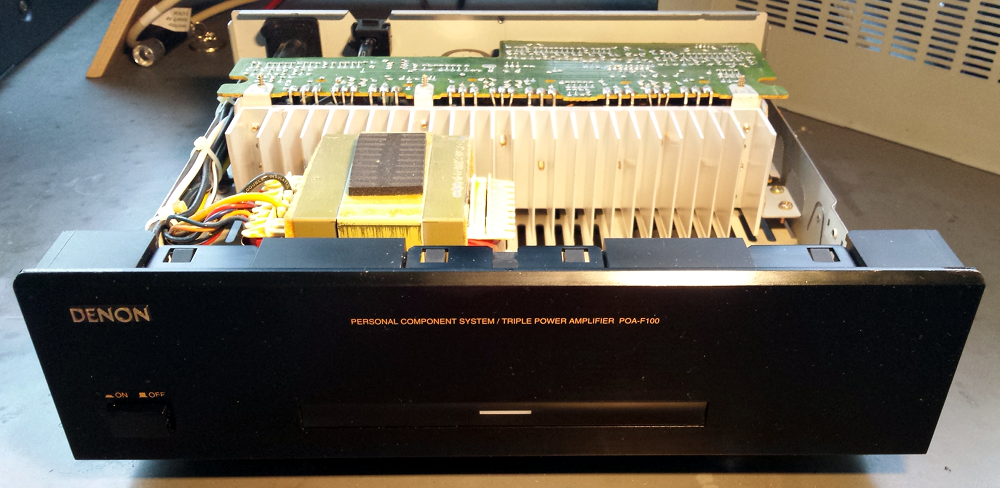
With the 73C in between the 731's the sound stage indeed is more firmly centered. Unfortunately the subwoofer pre-out has no crossover and the high tones emitted from the 73C influenced the stereo image. Now I needed a low-pass filter to dampen the high tones, with a crossover frequency just below the lowest frequency of the tweeter in the 73C and with no phase shift at all to not make the sound muddy.
Below photo shows an alternative solution that works well enough - instead of more electronics, a small wooden panel in front of the 73C (but not closing the bass-reflex port) disperses the sound of the tweeter enough to mitigate the influence on the stereo image. Effectively the wooden panel is my low-pass filter with zero phase shift! Note that this solution works in my small study. Another room may well require another solution.
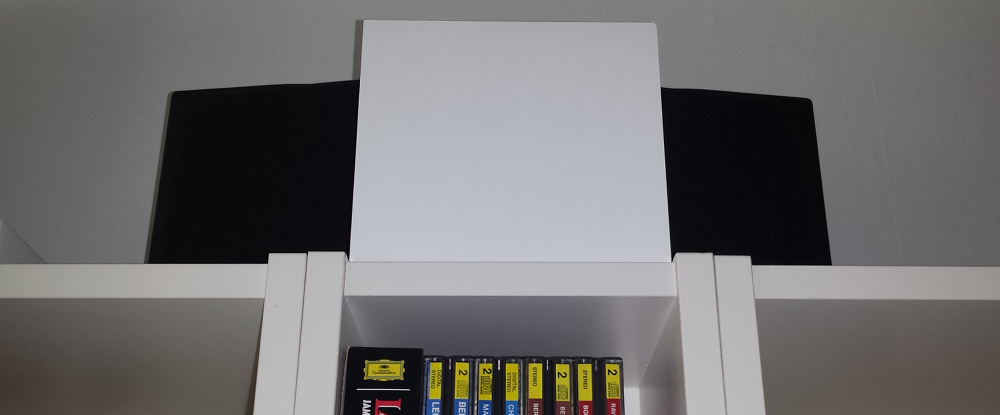
This Sony is an end-1990's CD/DVD player, a well-equipped all-metal-case model with for example a 24 bit pulsed D/A converter and digital outputs. Lately the player sat idly collecting dust and had the habit of incidentally skipping disc tracks, so it ended up at my desk. Unlike later DVD players, this one looks like normal HiFi equipment and can be stacked with your other units. This unit however is white, a rare colour for HiFi equipment, even back then.
Upon opening the case I found that this player is very well built, as can be seen in below picture. On the other hand, this quality is no surprise considering its price tag when new, which was a considerable even though DVD was a relatively new format at the time.
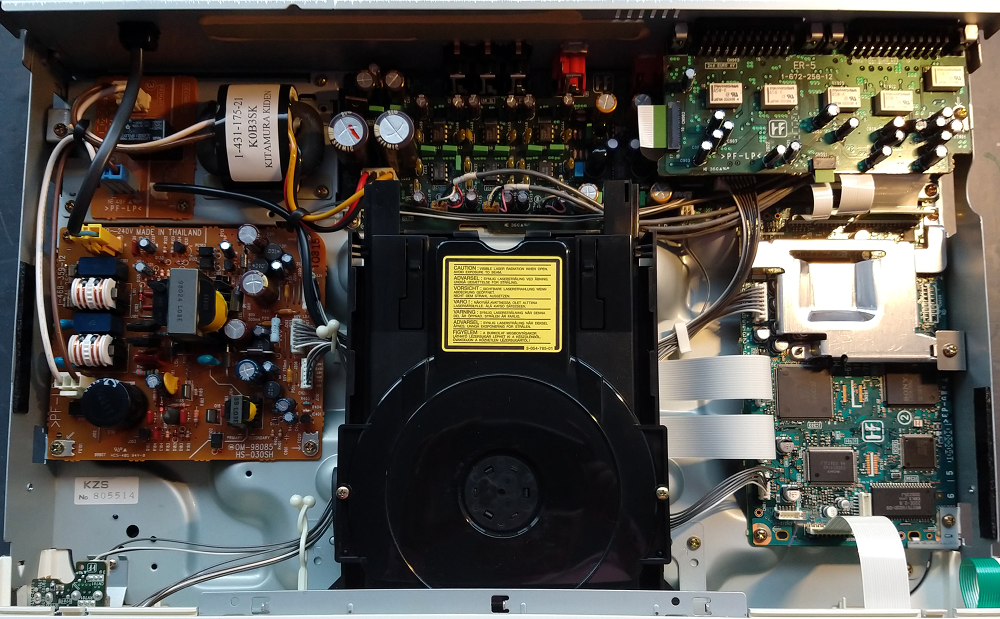
Since the unit had been exposed to tobacco smoke in the past, I suspected that a dirty laser lens might explain the track skipping. I opened the disc mechanism to clean it and the lens, with isopropyl-alcohol. The tray drive belt I left for the moment following the adage if it is not broken, do not fix it. Except for the disc mechanism there was little to service at this point except for removing some dust it had collected and cleaning the exterior. After this straightforward cleaning operation the unit functions normally - the track skipping is apparently cured.
When playing CDs the sound quality is at the same level as my trusted Onkyo's. Using analogue interconnects subtle differences can be noticed between the players but it is hard to say which player would be «better», so I will not make a subjective judgement. As noted above, using a digital interconnect gives slightly better defined bass, but that is about it. I am surprised with the good sound quality of my players from the 1990's; it almost makes me think that the main achievement of the past twenty years has been to bring down production cost …
|
© 2002-2025 J.M. van der Veer (jmvdveer@xs4all.nl)
|